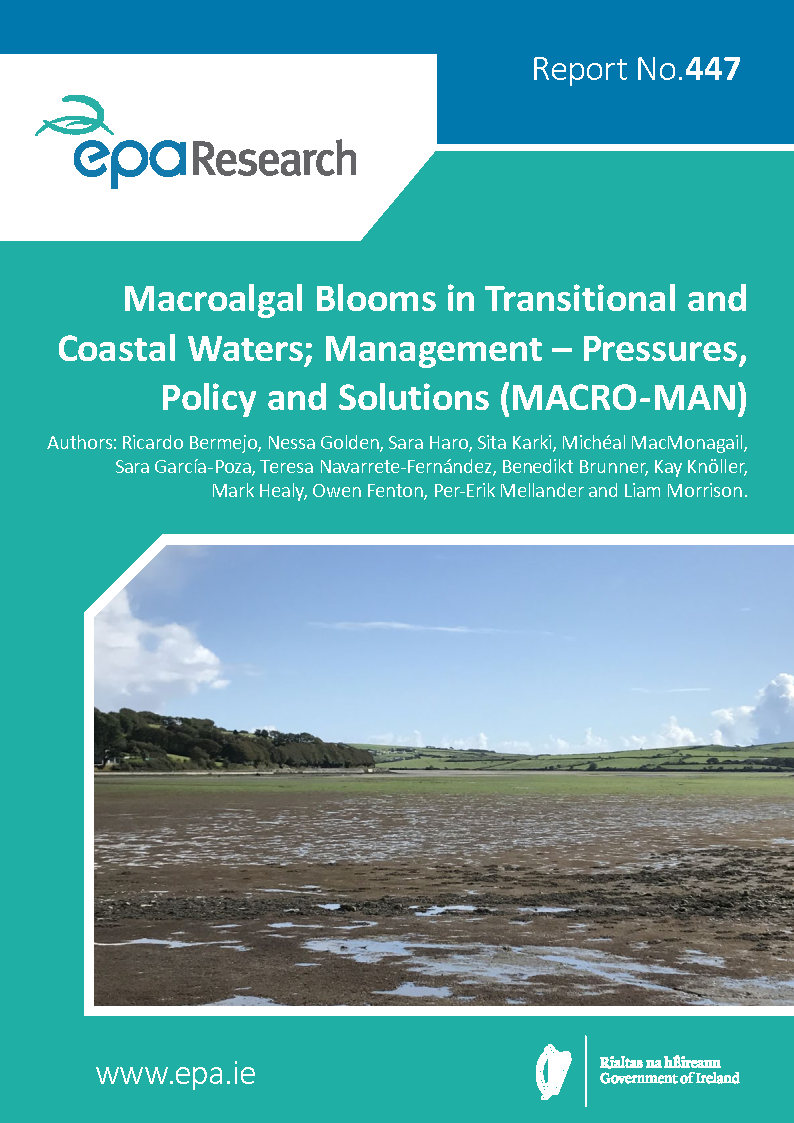Research 447: Macroalgal Blooms in Transitional and Coastal Waters; Management – Pressures,Policy and Solutions (MACRO-MAN)
Authors: Ricardo Bermejo, Nessa Golden, Sara Haro, Sita Karki, Michéal MacMonagail,Sara García-Poza, Teresa Navarrete-Fernández, Benedikt Brunner, Kay Knöller,Mark Healy, Owen Fenton, Per-Erik Mellander and Liam Morrison.
Summary: Eutrophication of waters and consequent algal blooms place significant pressure on marine ecosystems. Reducing the nutrient load of these waters is essential for ecosystem restoration. The MACRO-MAN project developed innovative methods to assess the environmental quality of Irish estuaries, and to identify drivers of and management strategies for macroalgal blooms. The potential risks associated with macroalgal blooms were considered in a global change context (e.g., climate change, emerging contaminants, biological invasions) in order to investigate the impact on ecosystem functioning and services provided by Irish estuaries. Using Earth Observation technologies, the project mapped the spatial and temporal distribution of brown, green and red macroalgal blooms in Irish estuaries, including the reconstruction of the invasion of a red Asian seaweed (Gracilaria vermiculophylla) in the Clonakilty estuary.

Project highlights video
Identifying pressures
Eutrophication of waters and consequent algal blooms place significant pressure on marine ecosystems. Reducing the nutrient load of these waters is essential for ecosystem restoration. The aim of the MACRO-MAN project was to develop innovative methods for the assessment of the environmental quality of Irish estuaries, and to identify drivers of and management strategies for macroalgal blooms. The potential risks associated with macroalgal blooms were considered in a global change context (e.g. climate change, emerging contaminants, biological invasions) in order to investigate the impact on ecosystem functioning and services provided by Irish estuaries. Earth observation technologies from the European Space Agency and algorithms developed during the project were used to map the spatial and temporal distribution of brown, green and red macroalgal blooms in Irish estuaries, including the reconstruction of the invasion of a red Asian seaweed (Gracilaria vermiculophylla) in the Clonakilty estuary. Based on the nitrogen isotopic signature of the bloom-forming species, agricultural sources of nitrogen were the biggest drivers of blooms in rural locations, while effluent from wastewater treatment plants was more relevant in urban areas. Tissue nitrogen and phosphorus content indicated that anthropogenic nitrogen enrichment of aquatic environments has produced a shift from a nitrogento a phosphorus-limited ecosystem.
Informing policy
From a policy perspective, the use of Earth observation technologies, including the use of free satellite imagery from the EU Copernicus and Landsat programmes for the monitoring of macroalgal blooms, including the spread of invasive bloom-forming species, is an important development. These technologies fulfil Irish legal obligations and comply with the EU Water Framework Directive and the EU Marine Strategy Framework Directive in terms of monitoring and assessment of the ecological and environmental status of transitional and coastal waters. The assessment of the nutrient status of macroalgal blooms based on the analysis of the tissue nitrogen and phosphorus content, and the nitrogen isotopic ratio, will be a direct indicator of the nutrient status of transitional and coastal waters, allowing for suitable assessment of strategies aimed at reducing and controlling eutrophication by identifying the most relevant limiting nutrient.
Developing solutions
A key recommendation from this project is that Earth observation technologies and nutrient bioassessment should be included in the monitoring of macroalgal blooms in Ireland. Furthermore, the report recommends controlling the spread of the alien red seaweed Gracilaria vermiculophylla, as the presence of this species could increase the extension and persistence of macroalgal blooms. We also recommended reducing nutrient loadings from agriculture and urban sources, and enhancing nutrient removal, actively and passively. In this sense, the restoration of oyster beds and seagrass meadows, which play an important role in nutrient and carbon sequestration, might be considered a mitigation strategy.
https://www.epa.ie/media/epa-2020/publications/research/Report-Cover.jpg